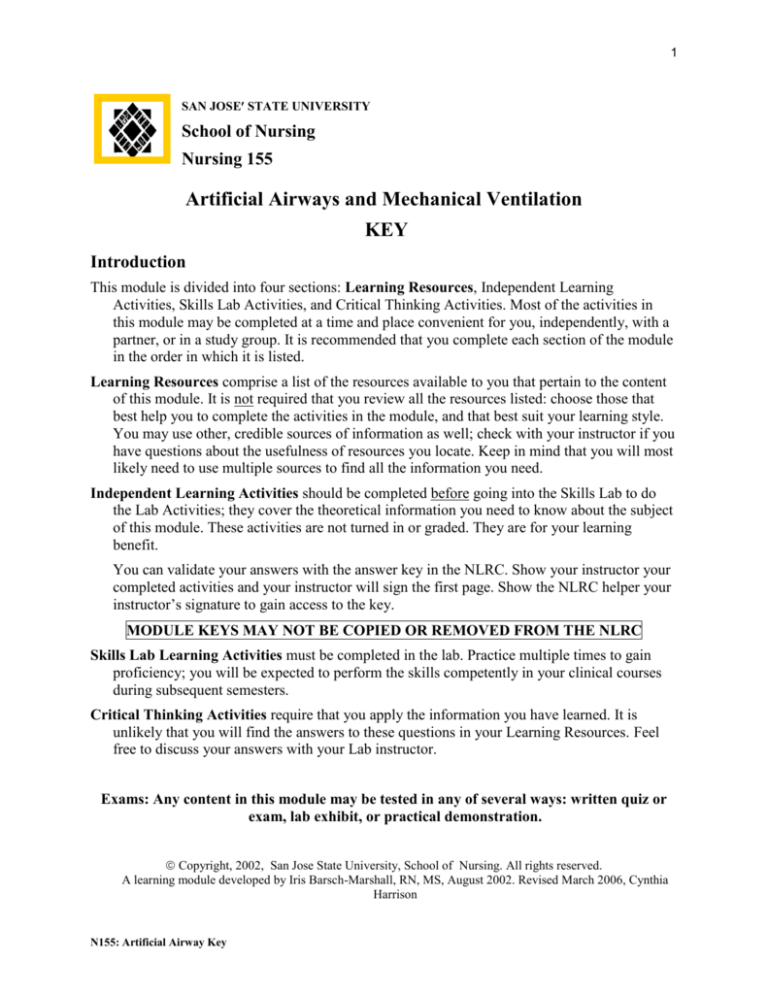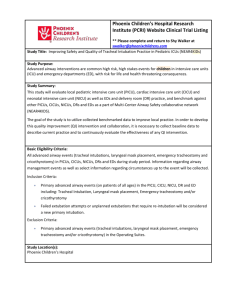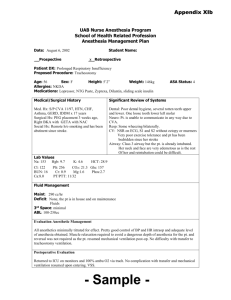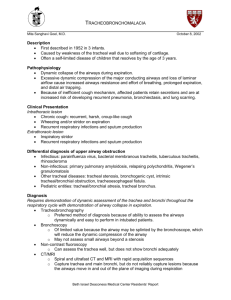
1
SAN JOSE STATE UNIVERSITY
School of Nursing
Nursing 155
Artificial Airways and Mechanical Ventilation
KEY
Introduction
This module is divided into four sections: Learning Resources, Independent Learning
Activities, Skills Lab Activities, and Critical Thinking Activities. Most of the activities in
this module may be completed at a time and place convenient for you, independently, with a
partner, or in a study group. It is recommended that you complete each section of the module
in the order in which it is listed.
Learning Resources comprise a list of the resources available to you that pertain to the content
of this module. It is not required that you review all the resources listed: choose those that
best help you to complete the activities in the module, and that best suit your learning style.
You may use other, credible sources of information as well; check with your instructor if you
have questions about the usefulness of resources you locate. Keep in mind that you will most
likely need to use multiple sources to find all the information you need.
Independent Learning Activities should be completed before going into the Skills Lab to do
the Lab Activities; they cover the theoretical information you need to know about the subject
of this module. These activities are not turned in or graded. They are for your learning
benefit.
You can validate your answers with the answer key in the NLRC. Show your instructor your
completed activities and your instructor will sign the first page. Show the NLRC helper your
instructor’s signature to gain access to the key.
MODULE KEYS MAY NOT BE COPIED OR REMOVED FROM THE NLRC
Skills Lab Learning Activities must be completed in the lab. Practice multiple times to gain
proficiency; you will be expected to perform the skills competently in your clinical courses
during subsequent semesters.
Critical Thinking Activities require that you apply the information you have learned. It is
unlikely that you will find the answers to these questions in your Learning Resources. Feel
free to discuss your answers with your Lab instructor.
Exams: Any content in this module may be tested in any of several ways: written quiz or
exam, lab exhibit, or practical demonstration.
Copyright, 2002, San Jose State University, School of Nursing. All rights reserved.
A learning module developed by Iris Barsch-Marshall, RN, MS, August 2002. Revised March 2006, Cynthia
Harrison
N155: Artificial Airway Key
2
SAN JOSE STATE UNIVERSITY
School of Nursing
Nursing 155
Artificial Airways and Mechanical Ventilation
KEY
Learning Resources
1. Elkin, M., Perry, A., & Potter, P. (2004). Nursing interventions and clinical skills (3rd
ed.) St. Louis, MO: Mosby. (pp.)
2. Potter, P.A. & Perry; A.G. (2005). Fundamentals of nursing: Concepts, process, and
practice (6th ed.). St. Louis, MO: Mosby. (pp. 1098-1117)
3. VT: Trach care. VT 170 (24 min.)
4. VT: Suctioning. VT 169 (34 min.)
5. Criteria sheets: Tracheostomy care, Trach and ET suctioning.
6. CD ROM: Oral & nasotracheal suctioning. CD015
7. CD ROM: Care of tracheostomy. CD020
8. Manno, M. S. (2005). Managing mechanical ventilation. Nursing 2005, 35(12), 36-41.
9. McConnell, E. A. (2000). Suctioning a tracheostomy tube. Nursing 2000, 30(1), 80.
10. Pruitt, B. (2005). Clear the air with closed suctioning. Nursing 2005, 35(7), 44-45.
11. Pruitt, B. & Jacobs, M. (2005). Clear away pulmonary secretions. Nursing 2005, 35(7),
36-41.
12. Pruitt, B. & Jacobs, M. (2006). Best practice interventions: How can you prevent
ventilator-associated pneumonia? Nursing 2006, 36(2), 36-41. (optional)
13. Rushing, J. (2006). Using bag-valve-mask ventilation. Nursing 2006, 36(1), 72.
N155: Artificial Airway Key
3
Independent Learning Activities
Learning Outcomes
1. List two indications for an artificial airway.
2. Distinguish between pharyngeal and tracheal airways and their indications for use.
3. Describe the purpose of inflating a tracheal cuff.
4. Determine when a tracheal cuff should be deflated.
5. State maximum tracheal cuff pressure.
6. Discuss why it is important to check tracheal cuff pressures on tracheal airways.
7. Describe three important nursing interventions for the patient with an oropharyngeal or
nasopharyngeal airway.
8. Describe five important assessments for the patient with an endotracheal tube.
9. Distinguish among nursing interventions for each of the four types of artificial airways.
10. List two reasons a patient may require mechanical ventilation.
11. List two complications related to the presence of tracheostomy.
12. list three benefits of tracheostomy as compared to ETT.
13. List three different alarms on a ventilator and the significance of each.
14. Identify two different modes of oxygen delivery for a patient with a tracheostomy.
15. Identify the purpose and procedure for sterile suctioning.
16. Identify the three types of airways through which the nurse can perform pulmonary suction.
17. State the maximum amount of time one can use to suction a patient from catheter passage to
its removal.
N155: Artificial Airway Key
4
Learning Activities
1. List two reasons a patient may require an artificial airway.
a. Maintain an open airway in an unconscious patient or a patient with a diminished gag
reflex
b. Patient requiring frequent nasopharyngeal suctioning
c.Aassist in ventilating a patient with absent or inadequate respirations
2. Complete the following table by briefly describing the anatomical locations and indications
for use of two pharyngeal airways and two tracheal airways.
Pharyngeal Airways
Tracheal Airways
1._ Oropharyngeal
1. Endotracheal tube
Anatomical location: Central portion of
the pharynx
Anatomical location: Trachea, via oral
cavity. End of tube should sit 5 to 7 cm
above carina in mainstem bronchus.
Used for patient requiring mechanical
ventilation.
Indications for use:
To maintain patent airway by keeping
tongue from obstructing; used for
unconscious pt w/absent or diminished
gag reflex.
2. nasopharyngeal airway
Indications for use:
Respiratory arrest, surgery, cardiac arrest,
trauma
Anatomical location: Through nasal
cavity to posterior pharynx
2. tracheostomy tube
Anatomical location: Trachea, surgically
inserted via anterior neck
Indications for use:
Indications for use:
Same as oropharyngeal airway, but
inserted via nares. Also used for patient
requiring frequent suctioning.
Long term mechanical ventilation (>21
days).
3. What is the purpose of inflating a tracheal cuff?
Prevent air leak
4. What is the maximum tracheal cuff pressure?
< 20 mmHg or < 25 cm H20
5. Why is it important to check cuff pressures on tracheal airways?
Overinflation can cause necrosis of tracheal tissue
N155: Artificial Airway Key
5
6. When is it appropriate to deflate a tracheal cuff?
When a patient is being weaned from the ventilator, or when a tracheostomy is going to be
plugged with a tracheostomy button or passey-muir valve, or the tracheostomy may be
plugged for brief periods when the patient is learning to manage their own airway. In
addition, the cuff may be deflated when the patient is learning to take food and fluid by
mouth; keeping the cuff inflated may make swallowing more difficult.
7. What are three important nursing interventions for the patient with an oropharyngeal or
nasopharyngeal airway?
a. frequent oral care
b. suction oral cavity and lungs as needed
c. assessment of mucosa; prevent breakdown
8. What are five important assessments for the patient with an endotracheal tube?
a. Breath sounds and respiratory rate
b. Quality and quantity of secretions
c. Temperature
d. Condition of oral or nasal mucosa
e. Ensure tube is taped securely and has not moved
9. Match the following nursing interventions with the type of airway each pertains to. More
than one airway may apply per intervention.
Airway
Intervention
a. Oropharyngeal
___d___ cleaning the inner cannula
b. Nasopharyngeal
__a,b,c,d_ sterile suctioning of lungs
c. Endotracheal
__a,b,c,d_ nonsterile oral suctioning
d. Tracheostomy
__a,b,c,d_ assess breath sounds
__a,b,c,d assess quality and quantity of
secretions
___a,b,c_ assess mucosa for breakdown
___d___ change dressing at insertion site
N155: Artificial Airway Key
6
10. List two reasons a patient may require mechanical ventilation.
a. Respiratory failure
b. Shock
c. Cardiac arrest
d. Surgery
e. Trauma
f. Neuromuscular disorders
11. List two complications related to the presence of tracheostomy.
a. Bleeding } most common
b. Infection } most common
c. Tube displacement
d. Obstruction
e. Cuff leakage
f. Tracheal erosion
g. Tracheoesophageal fistula
h. Death
12. List three benefits of tracheostomy as compared to ETT.
a. increases patient comfort
b. spares further direct laryngeal injury
c. improves patient’s ability to communicate
d. facilitates oral intake of food, thus providing psychological benefit
e. provides more secure airway and thus may facilitate ICU discharge
f. decrease airway resistance and thus may aid weaning in patients with marginal lung
function
13. List three different alarms on a ventilator and the significance of each.
a. High respiratory rate
significance:
Client may have increased metabolic demand for oxygen; pain or anxiety. Need to
assess client, calm and reassure her, evaluate ABG’s
N155: Artificial Airway Key
7
b. Low inspiratory pressure
significance:
Tubing may be unattached, there may be a leak around tube, or tube may be displaced
into pharynx or esophagus. Need to check if tubing attached and assess placement of
tube
c. High pressure limit
significance:
Possible airway obstruction, client fighting ventilator, or tubing kinked. Clear
obstruction, unkink tubing or reassure/sedate client.
14. Identify two modes of oxygen delivery for a patient with a tracheostomy
a. ventilator
b. mist collar
15. Identify the three types of airways through which the nurse can perform pulmonary suction.
a. nasopharyngeal
b. endotracheal
c. tracheostomy
16. What is the maximum amount of time one can use to suction a patient from catheter passage
to its removal?
15 seconds
N155: Artificial Airway Key




